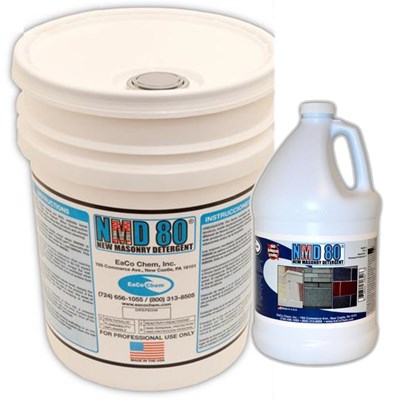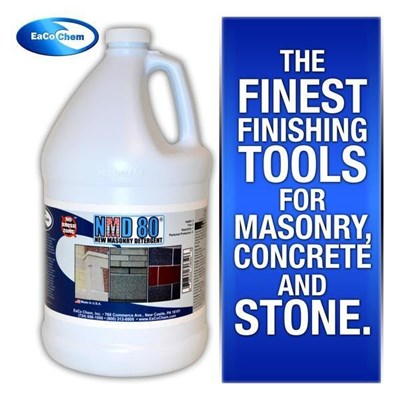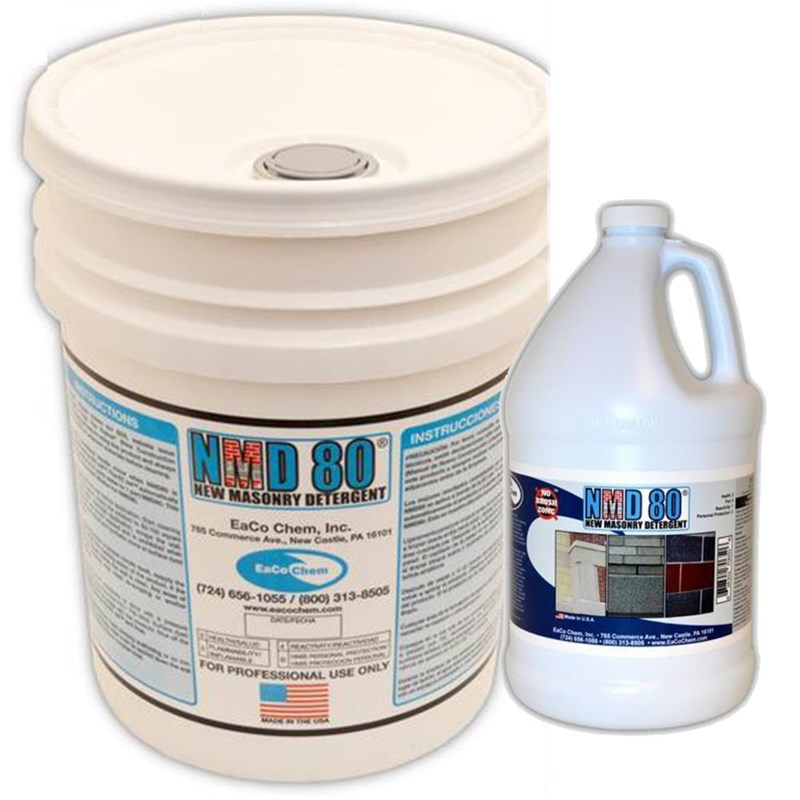EaCo Chem NMD80 Masonry Detergent
Quick Overview
- Detergent-based solution used to remove efflorescense and mortar smears
- Designed for use on masonry surfaces
- Powerful, yet safe for more delicate surfaces
- No brushing or scrubbing needed
Show More
NMD 80 is a powerful detergent-based solution designed for safe and effective removal of efflorescence and mortar smears from masonry surfaces.
It can be used on all masonry substrates including brick, stone, synthetic stone, pre-cast concrete, and designer or colored block.
Works great to remove polymeric sand haze.
The added buffering ingredients allow it to be powerful yet safe enough for glass and anodized aluminum.
It requires no respirator when working outdoors, preventing unnecessary fines.
This product is capable of extremely effective cleaning and efflorescence removal without brushing or scrubbing and will leave the cream on the mortar joints.
One Product - Multiple Substrates
- Red Brick
- Buff Brick
- Precast
- Stone Veneer
- Windows
- Burnished Block
- Ground Faced Block
- Natural Stone
- Limestone
- Colored MortarR
- Colored Block
- Granite (Non-Polished)
Advantages
- Safe on Most Surfaces
- Uses 80% Less Water
- Saves 90% More Time
- Spray On / Spray Off
Combine these cost reductions with heightened safety, excellent final appearance and a dramatic reduction in post cleaning stains and you have tomorrow’s chemistry today!
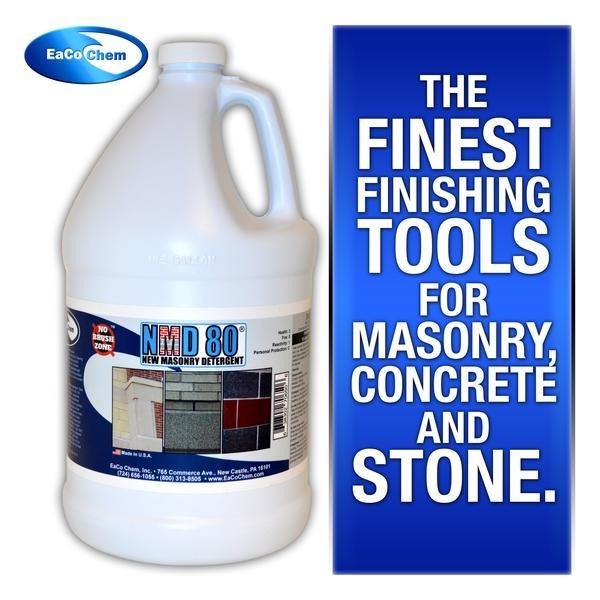
Residential Masonry Cleaning
Preclean
1. Always test windows and frames with the pencil test. (Pencil Test: Take a pencil, dip eraser end in undiluted NMD 80 and touch it to the window and frame. Allow product to sit for a minute then rinse it off. Observe results after drying. This test is not intended if windows are not installed before cleaning.)
2. Cover any hardware if doors or fixtures have been installed before cleaning.
Tools Required
1. EC Jet, NMD 80, and pressure washer give the fastest and best clean on all types of masonry substrates.
2. Residential cleaning is best done with ladders with stand off bars at top.
3. A large steel ladder hook in an “S” Configuration is required to hold bucket while cleaning from 28 feet 13 feet. 13 feet and below can be done from the ground as long as the pressure washer wand is 5 feet long and your cleaner stands 5’-10’ tall.
4. Best results occur when scaffold is removed prior to cleaning except for chimneys and gable ends.
Tips
1. For chimneys above 28’ cleaning should be done while scaffold is in place. NMD 80 has been used successfully with low pressure rinse in under 24 hours after but we recommend 24 hours curing time before cleaning. When cleaning chimneys, leave roof protection and mortar droppings in place while cleaning. This catches and helps neutralize any overspray or rundown.
2. For gables above 28’ cleaning time is the same as above. Cleaning should only be done down to 28’ line as working from scaffolding slows the cleaning process.
3. Cleaner should be furnished a shovel for leveling the ladder for stability and safety.
The Proper Cleaning Process for Sensitive Substrates
Subject: Removing excess mortar (post construction)
Product: NMD 80 (new masonry detergent)
Use NMD 80 to clean these surfaces at a 4:1 dilution ratio. (4 parts water to 1-part product) Apply the product with a low-pressure application through an EC Jet, X-Jet or low-pressure pump-up applicator.
(Always read over the specification sheet for details concerning the use of the EC-Jet, X-Jet.)
Exterior Application:
1. Prewet wall with water (do not soak)
2. Apply NMD 80 (at a 4:1 dilution ratio) from the top down. Let dwell up from 3 - 5 minutes.
(Note: Dwell time is determined by substrate and environmental conditions. Do not allow product to dry on the surface.)
3. If necessary, use a metal or plastic scraper to gently scrape wall after the first chemical application. Do not chip at or dig into the surface with the scraper. Keep scraper at a low angle to the wall. Do not brush surface dyed brick or block, brushing can cause color bleed. Do not brush ground face and/or burnished block. The grit from removing the excess mortar will scratch the surface.
4. Reapply NMD 80 or SOS-50 at a 4:1 dilution after a 3-5 minutes dwell time without rinsing. Let dwell for an additional 3 - 5 minutes without letting the chemical dry on the wall.
5. Rinse making sure each pass is even. For optimal efficiency use a pressure washer in the 3 -5 gallons per minute range with a 40º tip using no more than 300 p.s.i. Hold wand 8-12 inches from the wall when rinsing. A space rod attached to the rinsing nozzle will help keep the rinsing distance the same. Never use a zero, 15º or rotating zero-degree nozzle.
Important: Do not use high pressure or aggressive scrubbing on any sensitive substrates Use either a garden hose rinse or an equivalent with a pressure washer. (No more than 300 p.s.i.) or close the shut off valve on the EC Jet to use it as low-pressure rinse tool.
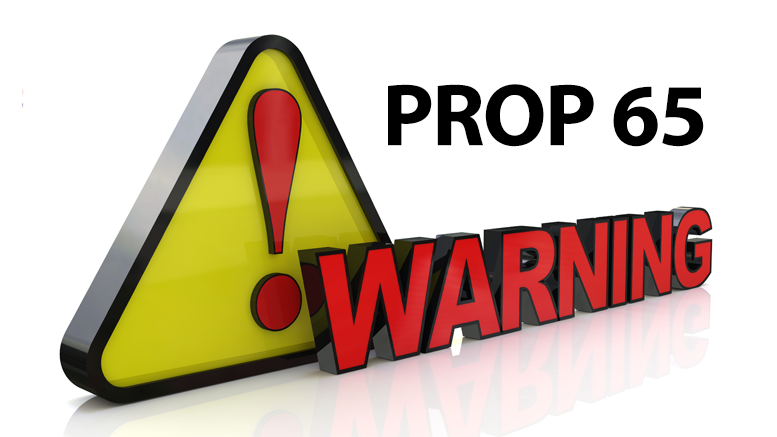
Proposition 65 requires businesses to provide warnings to Californians about significant exposures to chemicals that cause cancer, birth defects or other reproductive harm. These chemicals can be in the products that Californians purchase, in their homes or workplaces, or that are released into the environment. By requiring that this information be provided, Proposition 65 enables Californians to make informed decisions about their exposures to these chemicals. Proposition 65 also prohibits California businesses from knowingly discharging significant amounts of listed chemicals into sources of drinking water. Proposition 65 requires California to publish a list of chemicals known to cause cancer, birth defects or other reproductive harm. This list, which must be updated at least once a year, has grown to include approximately 900 chemicals since it was first published in 1987. Proposition 65 became law in November 1986, when California voters approved it by a 63-37 percent margin. The official name of Proposition 65 is the Safe Drinking Water and Toxic Enforcement Act of 1986.
The list of chemicals contains a wide range of naturally occurring and synthetic chemicals that include additives or ingredients in pesticides, common household products, food, drugs, dyes, or solvents. Listed chemicals may also be used in manufacturing and construction, or they may be byproducts of chemical processes, such as motor vehicle exhaust. For more information visit www.p65warnings.ca.gov/


